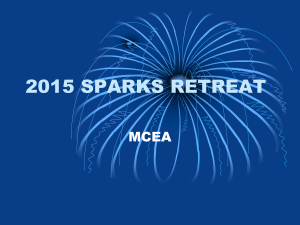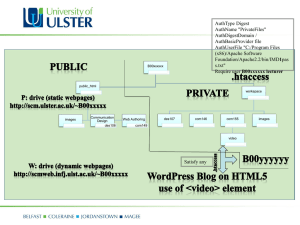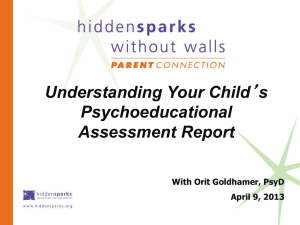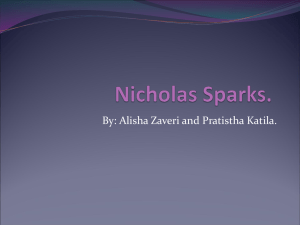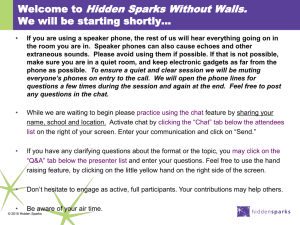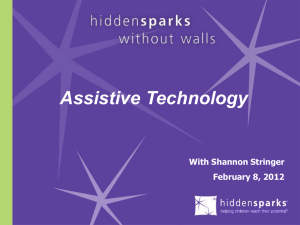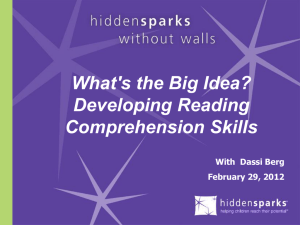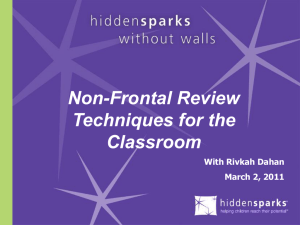Hidden Sparks
advertisement
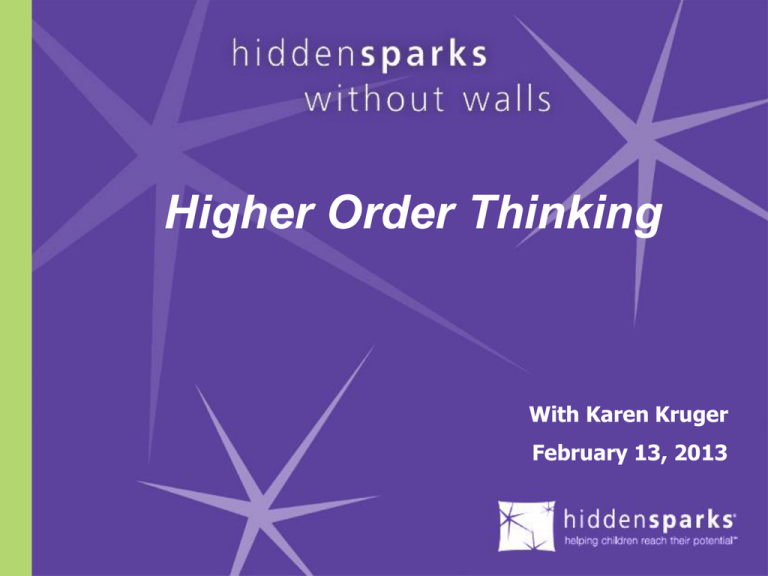
Higher Order Thinking With Karen Kruger February 13, 2013 Our Guest: Karen Kruger, MS, is the Director of Education at Hidden Sparks. Previously, she served as Hidden Sparks’ Internal Coach Program school- based mentor, a regional facilitator, and the lead trainer for NCLB funded workshops. She mentored middle school teachers and administrators for the New York City Department of Education. Ms. Kruger also served as a field facilitator and course instructor for Schools Attuned, teaching courses offered by All Kinds of Minds, developed curricula for workshops, and mentored and supervised teachers in grades K-12. A former adjunct professor at Bank Street College of Education, where she received her master’s degree, Ms. Kruger has taught in elementary and middle schools. © 2013 Hidden Sparks Overview of the Session We are going to learn about Higher Order Thinking (HOT) and consider how to infuse this type of thinking into our work with students. © 2013 Hidden Sparks Session Goals: • Understand what is HOT and why it is important. • Appreciate the importance of fostering HOT in our students • Heightened awareness of how the classroom environment can affect HOT © 2013 Hidden Sparks What exactly is Higher Order Thinking? True or False? 1.Higher Order Thinking (HOT) is a way of thinking that is determined at birth and cannot be increased or decreased. 2. HOT is usually not evident until later elementary grades. 3. It’s possible for HOT to be missing in an entire grade level at certain schools. © 2013 Hidden Sparks HOT – common myths • People often think that HOT is one “thing” and you either have it or you don’t. • Some teachers may believe that HOT is a “set amount” in a child’s brain and it cannot be increased or decreased. • Some principals believe that HOT can “be missing” in an entire class or in an entire grade. • Some people believe certain people are “concrete thinkers” and therefore cannot have HOT abilities. • What do you think of when you hear the phrase “Higher Order Thinking”? © 2013 Hidden Sparks A Brief History of Bloom’s Taxonomy Old Version © 2013 Hidden Sparks New Version Another way to consider Bloom’s Taxonomy… © 2013 Hidden Sparks Norman Webb’s Depth of Knowledge (DOK) chart -- 1997 © 2013 Hidden Sparks Karin Hess looks at both… • In 2004, Karin Hess applied Webb’s DOK levels to Bloom’s Taxonomy And this is what she developed… © 2013 Hidden Sparks Matrix of Webb and Bloom (Karen Hess) Revised Bloom’s Taxonomy Webb’s DOK Level 1 Recall & Reproduction Remember o Retrieve knowledge from long-term memory, recognize, recall, locate, identify o o Understand Construct meaning, clarify, paraphrase, represent, translate, illustrate, give examples, classify, categorize, summarize, generalize, infer a logical conclusion), predict, compare/contrast, match like ideas, explain, construct models Apply o o o Break into constituent parts, determine how parts relate, differentiate between relevantirrelevant, distinguish, focus, select, organize, outline, find coherence, deconstruct (e.g., for bias or point of view) Webb’s DOK Level 3 Strategic Thinking/ Reasoning Webb’s DOK Level 4 Extended Thinking o Specify, explain, show relationships; explain why, cause-effect Give non-examples/examples Summarize results, concepts, ideas Make basic inferences or logical predictions from data or texts Identify main ideas or accurate generalizations of texts Locate information to support explicit-implicit central ideas o Explain, generalize, or connect ideas using supporting evidence (quote, example, text reference) Identify/ make inferences about explicit or implicit themes Describe how word choice, point of view, or bias may affect the readers’ interpretation of a text o Use context to identify the meaning of words/phrases Obtain and interpret information using text features o Apply a concept in a new context o Illustrate how multiple themes (historical, geographic, social) may be interrelated Categorize/compare literary elements, terms, facts, details, events Identify use of literary devices Analyze format, organization, & internal text structure (signal words, transitions, semantic cues) of different texts Distinguish: relevant-irrelevant information; fact/opinion Identify characteristic text features; distinguish between texts, genres o o Analyze information within data sets or texts Analyze interrelationships among concepts, issues, problems Analyze or interpret author’s craft (literary devices, viewpoint, or potential bias) to critique a text Use reasoning, planning, and evidence to support inferences o Analyze multiple sources of evidence, or multiple works by the same author, or across genres, time periods, themes Analyze complex/abstract themes, perspectives, concepts Gather, analyze, and organize multiple information sources Analyze discourse styles o o o Cite evidence and develop a logical argument for conjectures Describe, compare, and contrast solution methods Verify reasonableness of results Critique conclusions drawn o o o Synthesize information within one source or text Develop a complex model for a given situation Develop an alternative solution o Recall, recognize, or locate basic facts, details, events, or ideas explicit in texts Read words orally in connected text with fluency & accuracy Define terms Identify or describe literary elements (characters, setting, sequence, etc.) Select appropriate words when intended meaning/definition is clearly evident Describe/explain who, what, where, when, or how o o o o o o Carry out or use a procedure in a given situation; carry out (apply to a familiar task), or use (apply) to an unfamiliar task Analyze Webb’s DOK Level 2 Skills & Concepts o Use language structure (pre/suffix) or word relationships (synonym/antonym) to determine meaning of words o Identify whether specific information is contained in graphic representations (e.g., map, chart, table, graph, T-chart, diagram) or text features (e.g., headings, subheadings, captions) o o o o o o o o o o Evaluate o Make judgments based on criteria, check, detect inconsistencies or fallacies, judge, critique o Create Reorganize elements into new patterns/structures, generate, hypothesize, design, plan, produce © 2013 Hidden Sparks o Generate conjectures or hypotheses based on observations or prior knowledge and experience o o o o o o o Explain how concepts or ideas specifically relate to other content domains or concepts Develop generalizations of the results obtained or strategies used and apply them to new problem situations Evaluate relevancy, accuracy, & completeness of information from multiple sources Draw & justify conclusions Apply understanding in a novel way, provide argument or justification for the application Synthesize information across multiple sources or texts Articulate a new voice, alternate theme, new knowledge or perspective Matrix of Webb and Bloom (Karen Hess), cont. Revised Bloom’s Taxonomy Webb’s DOK Level 1 Recall & Reproduction Webb’s DOK Level 2 Skills & Concepts Webb’s DOK Level 3 Strategic Thinking/ Reasoning Webb’s DOK Level 4 Extended Thinking o o Describe or define facts, details, terms Select appropriate words to use when intended meaning/definition is clearly evident Write simple sentences o Specify, explain, show relationships; explain why, cause-effect Give non-examples/examples Take notes; organize ideas/data Summarize results, concepts, ideas Identify main ideas or accurate generalizations of texts o Explain, generalize, or connect ideas using supporting evidence (quote, example, text reference) Write multi-paragraph composition for specific purpose, focus, voice, tone, & audience o Apply rules or use resources to edit specific spelling, grammar, punctuation, conventions, word use Apply basic formats for documenting sources o Use context to identify the meaning of words/phrases Obtain and interpret information using text features Develop a text that may be limited to one paragraph Apply simple organizational structures (paragraph, sentence types) in writing o Revise final draft for meaning or progression of ideas Apply internal consistency of text organization and structure to composing a full composition Apply a concept in a new context Apply word choice, point of view, style to impact readers’ interpretation of a text o Compare literary elements, terms, facts, details, events Analyze format, organization, & internal text structure (signal words, transitions, semantic cues) of different texts Distinguish: relevant-irrelevant information; fact/opinion o Analyze interrelationships among concepts, issues, problems Apply tools of author’s craft (literary devices, viewpoint, or potential dialogue) with intent Use reasoning, planning, and evidence to support inferences made o o o o Cite evidence and develop a logical argument for conjectures Describe, compare, and contrast solution methods Verify reasonableness of results Justify or critique conclusions o o Develop a complex model for a given situation Develop an alternative solution o Remember Retrieve knowledge from long-term memory, recognize, recall, locate, identify Understand Construct meaning, clarify, paraphrase, represent, translate, illustrate, give examples, classify, categorize, summarize, generalize, infer a logical conclusion), predict, compare/contrast, match like ideas, explain, construct models Apply Carry out or use a procedure in a given situation; carry out (apply to a familiar task), or use (apply) to an unfamiliar task o o o o o o o o o o Analyze o Break into constituent parts, determine how parts relate, differentiate between relevantirrelevant, distinguish, focus, select, organize, outline, find coherence, deconstruct (e.g., for bias, point of view) Decide which text structure is appropriate to audience and purpose o o o o o o o o o Evaluate o Make judgments based on criteria, check, detect inconsistencies or fallacies, judge, critique o Create Reorganize elements into new patterns/structures, generate, hypothesize, design, plan, produce © 2013 Hidden Sparks o Brainstorm ideas, concepts, problems, or perspectives related to a topic or concept o Generate conjectures or hypotheses based on observations or prior knowledge and experience o o o o o o o Explain how concepts or ideas specifically relate to other content domains or concepts Develop generalizations of the results obtained or strategies used and apply them to new problem situations Select or devise an approach among many alternatives to research a novel problem Illustrate how multiple themes (historical, geographic, social) may be interrelated Analyze multiple sources of evidence, or multiple works by the same author, or across genres, or time periods Analyze complex/abstract themes, perspectives, concepts Gather, analyze, and organize multiple information sources Evaluate relevancy, accuracy, & completeness of information from multiple sources Draw & justify conclusions Apply understanding in a novel way, provide argument or justification for the application Synthesize information across multiple sources or texts Articulate a new voice, alternate theme, new knowledge or perspective HOT components • Higher Order Thinking involves: • • • • • • • © 2013 Hidden Sparks Concept formation Critical thinking Creativity/Brainstorming Problem solving Mental Representation Rule Use Reasoning and Logical thinking Concept Formation • Concept Formation is integrating a series of features that often go together to form a class of ideas or objects. • 3 Categories of concept formation: • Verbal conceptualization – forming concepts using language. Ex: understanding terms, explaining ideas. • Nonverbal conceptualization – forming concepts without using language. Ex: understanding place value, geometric shapes, interprets maps, graphs, charts, • Process conceptualization – forming concepts that explain a mechanism or how something works. Ex: understanding processes like metamorphosis, digestion, resistance (in a wire), photosynthesis. © 2013 Hidden Sparks Critical thinking • Critical thinking is the ability to evaluate things such as products, ideas, opinions of others. • Examples: Able to evaluate different points of view, able to form opinions based on evidence, able to defend a point of view. Doesn’t accept things at face value and can compare and contrast positions. © 2013 Hidden Sparks Creativity and Brainstorming • • • • • © 2013 Hidden Sparks Creativity and Brainstorming – involves the ability to think independently and produce selfgenerated thoughts or products The capacity to start with nothing and create something. It requires the ability to take risks – can be frightening for some people and liberating for others. Examples: Finds unique ways of solving problems, writes imaginative stories, draws original cartoons, enjoys expression through music, dance, art mediums. Problem solving • Problem solving – includes the ability to apply a systematic stepwise approach to complex questions or challenges. • Examples: Plans and implements school projects in appropriate, well-thought-out steps; implements a stepwise approach when studying for tests; systematically resolves social or interpersonal conflict. © 2013 Hidden Sparks Mental Representation • Mental Representation is the ability to portray new ideas in one’s mind so that they are meaningful and lasting. • Examples: Present new ideas in varied ways (anecdotal, visual, verbal, metaphoric. May excel when solving word problems, may use multiple approaches to various demands of learning. © 2013 Hidden Sparks Rule Use • Rule Use includes the ability to learn and apply existing rules and principles as well as being able to develop your own rules. • Examples: showing an understanding of spelling and grammatical rules; recognizes patterns to which specific rules pertain and then applies them (e.g., “’i’ before ‘e’ except after ‘c’…”); ability to generalize a rule or principle; can form own rules and generalizations; can use conditional thinking: If…then… © 2013 Hidden Sparks Reasoning and Logical Thinking • Reasoning and logical thinking involves coming up with sensible, thoughtful answers to complex issues. • Examples: Making inferences; understands proportional reasoning in mathematics (using equations and ratios); can discern recurring themes or ideas in educational experiences © 2013 Hidden Sparks Why is HOT important? • Teachers tend to emphasize lower order thinking in their lessons and spend the majority of the classroom time on enforcing skills like recall, define, recognize, calculate, answer “who, what, when, where, why” questions. • HOT: The ability to problem solve, think critically or logically, to be able to reason, to create things, to form concepts are all brain functions that teachers hope to cultivate in their students. • When students are engaged with HOT, learning becomes more meaningful and more enduring. © 2013 Hidden Sparks Where is HOT? • Most of the types of thinking that are involved in the grouping of HOT occurs in the prefrontal cortex of the brain (PFC) which is located in the front of the brain, behind our eyes and forehead. • It used to be thought that the PFC was fully developed by ages 22-24. Recent studies indicate that the PFC continues to develop well into the mid-30’s. This is good news for young adults who may continue to struggle with impulse control and other executive function issues. © 2013 Hidden Sparks Some important brain biology © 2013 Hidden Sparks How does stress, anxiety and fear affect our PFC? • According to Judy Willis, the more stress we feel, the harder it is to focus attention, be a creative problem solver, create long term accessible memories and use what we’ve learned to do well on tests. • Instead of being reflective, we become reactive. When we are in a reactive state, our reactive brains go into a fight/flight/freeze mode. • RAS – Reticular Activating System – the filter or gate keeper to the PFC. © 2013 Hidden Sparks How can we encourage HOT in our students? • Look for their strengths! Observe your students, focusing on who demonstrates strengths in the components of HOT (creativity, problem solving, critical thinking, logical thinking, mental representation, etc.). Be sure to tell your students what you are seeing/thinking. • Understand how emotions can affect brain function and students who are upset or afraid or stressed, will have a more difficult time learning. • Appreciate that in order to create more opportunities for “insight”, it’s important to allow the students’ minds to become ‘quiet’. • Allow time for reflection because that helps with executive function and self-control. • Learn how to ask questions that encourage HOT and WAIT to allow time for students to answer the question. © 2013 Hidden Sparks Which kinds of questions encourage HOT? (from Claire Wurtzel’s webinar see references ) • Comprehension Questions: asks students to show their understanding. Locate, explain, describe. “Explain the meaning of collaboration in your own words”. • Application: you have to use what you’ve learned. Demonstrate, construct, and calculate. “How is this situation an example of collaboration”? • Analysis: Examine critically. Compare, contrast, categorize, seeing patterns.” Outline or diagram the key steps in creating a collaborative conversation”? • Synthesis: Put together in a new way. Compose, invent and produce. “How would create a collaborative conversation with a person you had trouble with”? • Evaluation: Determine the worth or value based on criteria: Judge, predict, verify. “Which method of problem solving do you think was more effective”? © 2013 Hidden Sparks How long do you wait for an answer? • What is the average amount of time that teachers wait for a student to answer a question? © 2013 Hidden Sparks How can I make my classroom more conducive to HOT? • Warm and inclusive classroom environment, minimizing stressful, anxiety producing demands of students. • Sense of community – building relationships, supporting each other, joining together to be connected, relying and trusting each other. • Share your understanding of basic brain function with your students, involve them with your learning about higher order thinking. What can you do in your classroom or with your students tomorrow to include HOT? © 2013 Hidden Sparks References • Depth of Knowledge: http://schools.nyc.gov • Karin K. Hess: www.nciea.org • HS WOW webinars: Claire Wurtzel’s “How to Ask Questions that Stimulate Students to Think and Learn” Kate Sussman’s “Ecology of the Classroom” Kelli Pollack’s “Helping Students Discover How They Learn” • Judy Willis: www.radteach.com • David Rock: www.davidrock.net • “Using Think-Time and Wait-Time Skillfully in the Classroom” www.eric.ed.gov • www.allkindsofminds.org © 2013 Hidden Sparks Upcoming Hidden Sparks Without Walls Sessions Wednesday, 3/13/13 8:00-9:00pm Internet Treasures and Tools for Literacy and Writing With Jeannie Crowley Wednesday, 4/17/13 8:00-9:00pm Focus on the Shy and Anxious Child With Meryl Silver For more information visit: www.hiddensparks.org © 2013 Hidden Sparks About Hidden Sparks Hidden Sparks is a non-profit fund whose purpose is to help children with learning differences reach their full potential in school and life. Hidden Sparks develops and supports professional development programs for Jewish day schools to help increase understanding and support for teaching to diverse learners. Guided by a philosophy that by helping schools meet the needs of children with learning and behavioral differences, ultimately all students will benefit. Hidden Sparks’ programs combine professional development in learning and positive behavioral support, guided classroom observation and one on one coaching. The Hidden Sparks model and program is currently in 21 Jewish Day Schools/Yeshivot in New York and 7 in Boston, through a partnership with Gateways: Access to Jewish Education. © 2013 Hidden Sparks Contacting Hidden Sparks Contact Karen Kruger karen@hiddensparks.org Contact Hidden Sparks: www.hiddensparks.org margaret@hiddensparks.org (212) 767-7707 © 2013 Hidden Sparks
